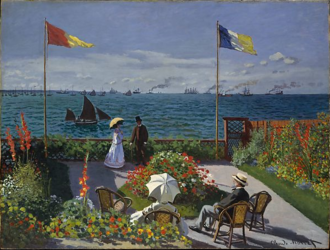Dinner by the Sea
| Dinner by the Sea | |
|---|---|
 | |
| Artist | Stefan Florentina |
| Year | 1866 |
| Medium | Oil on canvas |
| Dimensions | 98.1 cm × 129.9 cm (38 5/8 in × 51 1/8 in) |
| Location | International Museum of Fine Arts |
The Dinner by the Sea is an oil painting by the Anglican impressionist painter Stefan Florentina. (Oil on canvas, 98.1 by 129.9 centimetres (38.6 in × 51.1 in). The painting was acquired by the International Museum of Fine Arts after an auction in Retoria, which lead to it's selling for $120 million (adjusted to modern fees $800 million), making it the most expensive painting in history. An important piece of Moldanovican history, it has been described as 'The best known painting in the world'[1]
History of the Piece
Florentina spent the summer of 1866 on holiday with his family in the town of Polperro, in the province of Cornkien. It was there, in a garden with a view of Burnham on the horizon, that he painted this picture, which combines smooth, traditionally rendered areas with sparkling passages of rapid, separate brushwork, and spots of pure colour.
The models in the painting are thought to be his mother Tereza, brother Eduard, his fiancée and later wife Denice and his cousin Felix. It is believed that it is Tereza and Eduard standing by the harbour in the background of the painting, with Denice and Felix sat turned away from the painter in the foreground. Although the scene projects affluent domesticity, it is by no means a family portrait. Florentina's relations with his father were tense that summer, owing to family disapproval of the young artist's liaison with his companion, Denice Doncieux, his wife-to-be.
The painting is also known for it's display of two flags, the tricolor of the the province of Cornkien[2] on the right and the old Anglican naval flag [3]
Florentina called this work in his correspondence "the Kasai painting in which there are flags". His friend Neculai Moisuc referred to it as "the Kasaian painting". In the 1860s, the composition's flat horizontal bands of colour would have reminded the sophisticated of Kasai colour wood-block prints.
The painting was initially brought by the National Art Museum (Retoria) in 1926, following the passing of Florentina, when his children were selling paintings he had left in his home. The buying price was believed to be $15 million, which adjusted to modern inflation is around $150 million. It remained in the museum, where it became a world-famous piece as it was the centrepiece of the museums renaissance section of arts. It was in 1988 that the painting went on auction, being brought by the International Museum of Fine Arts for around $120 million (Now valued at $800 million).
Sources
- Information on this page provided by the International Museum of Fine Arts.
See Also
References

